2 Chronicles 5 meaning explained in AI Summary
This chapter details the grand ceremony of bringing the Ark of the Covenant to the newly built temple in Jerusalem by King Solomon.
1. The Ark's Arrival (verses 1-10):
- Solomon summons the elders, leaders, and heads of families to Jerusalem.
- They bring the Ark of the Covenant from the City of David (Zion) to the Temple Mount.
- The Ark, containing the stone tablets of the covenant, is carried by the priests.
- The procession is accompanied by immense sacrifices and music, creating a joyous atmosphere.
2. The Glory of the Lord Fills the Temple (verses 11-14):
- As the priests enter the Holy Place and place the Ark in the inner sanctuary (the Holy of Holies), the cloud of the Lord's glory fills the temple.
- The priests are unable to continue their service because of the overwhelming presence of God.
3. Solomon's Prayer of Dedication (verses 11-14):
- Solomon acknowledges the Lord's faithfulness to his promises to David.
- He praises God for choosing to dwell in the temple.
- He prays that the Lord would hear the prayers of his people when they face the temple.
Significance:
This chapter marks a pivotal moment in Israel's history. The Ark, representing God's presence and covenant with his people, finds its permanent dwelling place in the temple. The overwhelming glory of God filling the temple signifies his acceptance of Solomon's work and his continued presence among his people. This event solidifies Jerusalem as the religious center for Israel.
2 Chronicles 5 bible study ai commentary
2 Chronicles chapter 5 details the climatic culmination of the Temple's construction: its consecration. The chapter transitions from the finished physical structure to its spiritual purpose by documenting the installation of the sacred furnishings, particularly the Ark of the Covenant. The climax is the unified worship of the priests and Levites, which is met by God's manifest presence in the form of a glory-cloud (Kavod) so overwhelming that it fills the sanctuary, signifying His divine acceptance and indwelling.
2 Chronicles 5 context
The events occur during the height of the Israelite monarchy under King Solomon, around 960 B.C. The Temple was the fulfillment of God's promise and David's deep desire for a permanent, central sanctuary for the worship of Yahweh. In the Ancient Near East, temples were seen as the literal dwelling places of a nation's god. The construction of a magnificent temple was a statement of a king's power and the preeminence of his deity. However, Israel's theology was distinct: Solomon himself acknowledges that God cannot be contained in a temple (2 Chr 6:18). This chapter, therefore, acts as a polemic against paganism, showing that while God chooses to place His name and presence in a specific location, He is not a static idol but a living, dynamic God whose glory is a responsive and powerful force.
2 Chronicles 5:1
Thus all the work that Solomon made for the house of the Lord was finished: and Solomon brought in all the things that David his father had dedicated; and the silver, and the gold, and all the instruments, put he among the treasures of the house of God.
In-depth-analysis
- Completion and Consecration: This verse acts as a bridge. The physical work is "finished," and now the spiritual "filling" begins.
- Honoring David: Solomon doesn't just use his own wealth; he first brings in the "things that David his father had dedicated." This demonstrates continuity, fulfillment of his father's vision, and reverence for his legacy. These items were spoils of war dedicated to God, signifying that Israel's victories belonged to Yahweh.
- Treasury: These treasures were not for decoration but were sacred property stored in the temple's treasury, separate from the primary ceremonial vessels.
Bible references
- 1 Kings 7:51: 'So all the work that King Solomon had done for the house of the LORD was finished...' (A direct parallel account).
- 2 Samuel 8:10-12: 'King David also dedicated these to the LORD, along with the silver and gold that he had dedicated from all the nations which he had subdued...' (The origin of the dedicated things).
- 1 Chronicles 29:2-8: 'So I have provided for the house of my God...' (David’s personal and extensive preparations for the Temple).
Cross references
1 Chr 22:14 (David's provision); Num 31:54 (precedent for dedicating war spoils); Ezra 8:28-30 (careful handling of holy things).
2 Chronicles 5:2-3
Then Solomon assembled the elders of Israel, and all the heads of the tribes, the chief of the fathers of the children of Israel, unto Jerusalem, to bring up the ark of the covenant of the Lord out of the city of David, which is Zion. Wherefore all the men of Israel assembled themselves unto the king in the feast which was in the seventh month.
In-depth-analysis
- National Assembly: This was not a private or exclusively priestly event. Solomon convenes the entire leadership of the nation—elders, tribal heads, family chiefs. This highlights the Temple as a unifying center for all of Israel.
- The Ark's Journey: The ark is moved from the "city of David" (the lower, eastern hill) up to the Temple Mount (Mount Moriah). This short physical journey represents a monumental theological ascent from a temporary tent to its final, glorious resting place.
- Seventh Month Feast: The dedication is timed to coincide with the Feast of Tabernacles (Sukkot). This is profoundly significant, as this feast commemorated God dwelling with His people in the wilderness in a temporary structure (the Tabernacle). Now, God will dwell with them in a permanent structure, bringing the theme of "God with us" to a new height.
Bible references
- Leviticus 23:34: '...on the fifteenth day of this seventh month is the Feast of Tabernacles...' (The law for the designated feast).
- John 7:2, 37: 'Now the Jews’ Feast of Tabernacles was at hand... Jesus stood and cried out, “If anyone thirsts, let him come to me and drink.”' (Jesus fulfills the themes of this feast).
- 2 Samuel 6:12: '...So David went and brought up the ark of God from the house of Obed-edom to the City of David with gladness.' (Recalls David's earlier successful attempt to bring the Ark to Jerusalem).
Cross references
Deut 16:13-15 (commands for Tabernacles); Num 10:3 (use of trumpets for assembly); Neh 8:14-18 (post-exilic celebration of this feast).
2 Chronicles 5:4-5
And all the elders of Israel came; and the Levites took up the ark. And they brought up the ark, and the tabernacle of the congregation, and all the holy vessels that were in the tabernacle, these did the priests and the Levites bring up.
In-depth-analysis
- Levitical Duty: The text explicitly states, "the Levites took up the ark," respecting the divine command that only Levites (specifically the Kohathites) were to carry the sacred objects. The Chronicler, likely a priest or Levite himself, is meticulous about correct protocol.
- The Tabernacle Comes Home: Not just the Ark, but the original "tabernacle of the congregation" (Hebrew: Ohel Mo'ed) and its vessels are brought up. The mobile, wilderness sanctuary is absorbed into the permanent Temple. This act symbolizes the final transition and retirement of the old system as its sanctity is transferred and fulfilled in the new.
Bible references
- Numbers 4:15: 'And when Aaron and his sons have finished covering the sanctuary... after that the sons of Kohath shall come to carry it...' (The specific command for carrying the Ark).
- 1 Chronicles 15:2, 15: '...none ought to carry the ark of God but the Levites...' (David's correction after the tragedy of Uzzah).
- Hebrews 9:21: 'Then likewise he sprinkled with blood both the tabernacle and all the vessels of the ministry.' (The Tabernacle as a "type" or pattern of heavenly things).
Cross references
Josh 3:3 (priests carrying the Ark); Deut 31:9 (Levites bear the Ark); 1 Kin 8:3-4 (parallel account).
2 Chronicles 5:6
Also king Solomon, and all the congregation of Israel that were assembled unto him before the ark, sacrificed sheep and oxen, that could not be told nor numbered for multitude.
In-depth-analysis
- Extravagant Sacrifice: The language "could not be told nor numbered" is a deliberate hyperbole to convey an unimaginable quantity. These were likely fellowship offerings, expressing joy, thanksgiving, and consecration of the people and the moment.
- Focus on the Ark: The sacrifices happen "before the ark," underscoring that the Ark represents the very presence and throne of God, and all worship is directed toward Him.
Bible references
- 1 Kings 8:5: '...sacrificing sheep and oxen, which could not be counted or numbered for multitude.' (Exact parallel).
- Genesis 22:13: 'So Abraham went and took the ram, and offered it up for a burnt offering instead of his son.' (The foundational concept of substitutionary offering).
- Hebrews 10:4: 'For it is not possible that the blood of bulls and goats could take away sins.' (NT perspective on the limitation of these sacrifices, which pointed to a future reality).
Cross references
2 Sam 6:13 (David's sacrificing); 1 Chr 29:21 (vast sacrifices at Solomon's coronation); Lev 3:1-17 (law of fellowship offerings).
2 Chronicles 5:7-9
And the priests brought in the ark of the covenant of the Lord unto his place, to the oracle of the house, into the most holy place, even under the wings of the cherubims: For the cherubims spread forth their wings over the place of the ark, and the cherubims covered the ark and the staves thereof above. And they drew out the staves of the ark, that the ends of the staves were seen from the ark before the oracle; but they were not seen without. And there it is unto this day.
In-depth-analysis
- Final Resting Place: The Ark is placed in the "oracle" (Hebrew: Debir), the inner sanctum or Most Holy Place.
- Under the Wings: It rests under the wings of the massive, newly-carved cherubim which were part of the Temple itself. The Ark's own cherubim are now overshadowed by the Temple's, symbolizing God's enthronement in His new palace-throne room. The wings provide a canopy over God's mercy seat.
- Visible Staves: The detail about the carrying poles being partially visible from the Holy Place (the chamber just outside the Most Holy Place) but not from further out is a specific architectural detail suggesting an eyewitness account. It created a sense of "accessible hiddenness," reminding the ministering priests of the potent presence just behind the veil, without fully revealing it.
- "Unto this day": This phrase, common in historical biblical texts, indicates the source material for Chronicles was written while the First Temple was still standing, before its destruction in 586 B.C.
Bible references
- Exodus 25:20, 22: 'The cherubim shall stretch out their wings above... and there I will meet with you...' (The original Tabernacle blueprint).
- 1 Kings 8:6-8: (The parallel account, with nearly identical details).
- Hebrews 9:3-5: '...behind the second curtain was a room called the Most Holy Place, which had... the ark... overshadowed by the cherubim of glory.' (NT remembrance of the Temple's layout).
Cross references
Ex 37:7-9 (construction of Ark's cherubim); Ps 80:1 ("You who are enthroned upon the cherubim, shine forth.").
2 Chronicles 5:10
There was nothing in the ark save the two tables which Moses put therein at Horeb, when the Lord made a covenant with the children of Israel, when they came out of Egypt.
In-depth-analysis
- The Covenant Alone: This verse makes a definitive, critical statement. By Solomon's time, only the two stone tablets of the Ten Commandments were inside the Ark.
- Focus on the Word: The Chronicler's emphasis is that the foundation of Israel's relationship with God is His Word, His Covenant Law (Torah). The Temple's ultimate purpose is centered on this covenant.
- Polemics: This might be a subtle correction or clarification of traditions that had arisen. It emphasizes that Israel's God is not known through magical relics but through His revealed, unchanging word. Compared to pagan religions centered on idols and myth, Israel is centered on a historical covenant founded on divine law.
Bible references
- Deuteronomy 10:5: 'And I turned and came down from the mountain, and put the tablets in the ark which I had made; and there they are, as the LORD commanded me.' (Moses confirms placing only the tablets in the Ark).
- 1 Kings 8:9: 'There was nothing in the ark except the two tablets of stone...' (Identical statement in the parallel account).
- Hebrews 9:4: '...which had the golden censer and the ark of the covenant... in which were the golden pot that had the manna, Aaron’s rod that budded, and the tablets of the covenant...' (NT author references an earlier tradition or understanding where these items were associated with or kept near the Ark). This is not a contradiction, but reflects different time periods; by Solomon's era, only the tablets remained inside.
Cross references
Ex 34:27-28 (the covenant tablets); Jer 31:33 (the New Covenant where the law is written on hearts).
2 Chronicles 5:11-13a
And it came to pass, when the priests were come out of the holy place: (for all the priests that were present were sanctified, and did not then wait by course: Also the Levites which were the singers, all of them of Asaph, of Heman, of Jeduthun, with their sons and their brethren, being arrayed in white linen, having cymbals and psalteries and harps, stood at the east end of the altar, and with them an hundred and twenty priests sounding with trumpets:) It came to pass, as the trumpeters and singers were as one, to make one sound to be heard in praising and thanking the Lord; and when they lifted up their voice with the trumpets and cymbals and instruments of musick, and praised the Lord, saying, For he is good; for his mercy endureth for ever
In-depth-analysis
- Unified Priesthood: Priests were not serving "by course" (mishmarot, their regular divisions/rotations). For this ultimate event, all sanctified priests participated, showing unparalleled unity.
- Orchestra of Praise: This details the Levitical choirs and orchestras organized by David (led by Asaph, Heman, Jeduthun). Their white linen signified purity and their role as ministers. The massive sound involved stringed instruments, percussion, and 120 trumpets—a number signifying fullness and divine government (12 tribes x 10).
- "As One": The Hebrew emphasizes their perfect unity (ke'echad). Their sound was singular, reflecting a singular heart of praise. This unity is the immediate catalyst for God's response.
- The Anthem of Israel: They sing the quintessential song of praise: "For He is good; for his steadfast love (Hebrew: hesed) endures forever." Hesed is a rich term meaning covenant faithfulness, mercy, and loyal love. This phrase is the heartbeat of Israel's worship.
Bible references
- Psalm 136:1: 'Oh, give thanks to the LORD, for He is good! For His mercy endures forever.' (The great Hallel psalm, entirely based on this refrain).
- 1 Chronicles 25:1, 6: 'David... separated for the service some of the sons of Asaph, of Heman, and of Jeduthun... to prophesy with harps...' (The establishment of these musical guilds).
- Ezra 3:11: 'And they sang responsively, praising and giving thanks to the LORD: “For He is good, For His mercy endures forever toward Israel.”' (The same song used at the foundation of the Second Temple).
Cross references
1 Chr 15:16 (organizing musicians); 2 Chr 7:3, 20:21 (use of this song); Rev 5:8-9 (heavenly worship with harps and song); Col 3:16 (admonition for NT worship with psalms and hymns).
2 Chronicles 5:13b-14
that then the house was filled with a cloud, even the house of the Lord; So that the priests could not stand to minister by reason of the cloud: for the glory of the Lord had filled the house of God.
In-depth-analysis
- The Divine Response: The moment the praise becomes unified, God responds. The "cloud" is the visible manifestation of God's holy presence, often called the Shekinah Glory in later Jewish thought.
- Overwhelming Presence: God's glory (Kavod, literally "heaviness" or "weight") is so potent that the consecrated priests cannot remain. It demonstrates the infinite gap between the holy God and humanity, even His ordained ministers. God takes possession of His own house; man must step aside.
- God's "Amen": This event is the divine seal of approval on the Temple, the priesthood, and the unified worship of His people. He has accepted their offering and will now dwell among them.
Bible references
- Exodus 40:34-35: 'Then the cloud covered the tabernacle... and the glory of the LORD filled the tabernacle. And Moses was not able to enter...' (The direct parallel at the dedication of the Tabernacle).
- 1 Kings 8:10-11: '...the cloud filled the house of the LORD, so that the priests could not continue ministering because of the cloud...' (The parallel account in Kings).
- John 1:14: 'And the Word became flesh and dwelt [literally "tabernacled"] among us, and we have seen his glory...' (Jesus is the ultimate embodiment of God's glory dwelling with humanity).
- Revelation 21:3: 'And I heard a loud voice from heaven saying, “Behold, the tabernacle of God is with men, and He will dwell with them...”' (The ultimate fulfillment of the Temple's purpose).
Cross references
Eze 10:4 (Ezekiel sees this same glory depart the Temple); Acts 2:2-4 (the Holy Spirit filling believers, the new temple); 1 Cor 3:16 (the Church as God's temple).
2 Chronicles 5 chapter analysis
- From Moses to Solomon: The chapter intentionally links Solomon's Temple back to Moses' Tabernacle. Key elements—the Ark, the sacred vessels, the priesthood, and especially the glory-cloud—show that this is not a new religion but the culmination of God's covenant plan established at Sinai.
- A Polemic Against Idolatry: Unlike pagan temples which housed a man-made idol that was ceremonially "brought to life," Israel's Temple remains empty until the invisible, living God Himself fills it with His uncontrollable, dynamic presence. The focus is on a relationship with a living being, not reverence for an object.
- The Theology of the Missing Items: While 2 Chronicles 5:10 states only the tablets were in the Ark, Hebrews 9:4 mentions Aaron's rod and the pot of manna. A theological interpretation sees a beautiful fulfillment in this "gap." The items representing sustenance (Manna) and priesthood/resurrection (Aaron's Rod) were removed, pointing forward to the one who would be the true Bread of Life (John 6) and the true Resurrection and eternal High Priest (Hebrews 4-5). Only the Law remained, which would finally be fulfilled by Christ and written on believer's hearts (Jeremiah 31:33, Romans 10:4).
- The Pre-requisite for God's Glory: The chapter's structure reveals a pattern: careful preparation according to God's word (v. 1-10) followed by unified, passionate worship (v. 11-13a) leads directly to the manifestation of God's presence (v. 13b-14). Unity in worship is presented as a key that unlocks a visible response from God.
2 Chronicles 5 summary
Solomon completes the Temple and, following protocol, gathers all Israel to bring the Ark of the Covenant to its permanent home in the Most Holy Place. In an act of supreme national worship, unified Levitical choirs and a massive priestly orchestra praise God, singing of His goodness and eternal love. In a dramatic response, the very glory of God descends as a cloud, filling the Temple so powerfully that the priests cannot stand, signifying God’s acceptance and His awesome presence now dwelling with His people.
2 Chronicles 5 AI Image Audio and Video
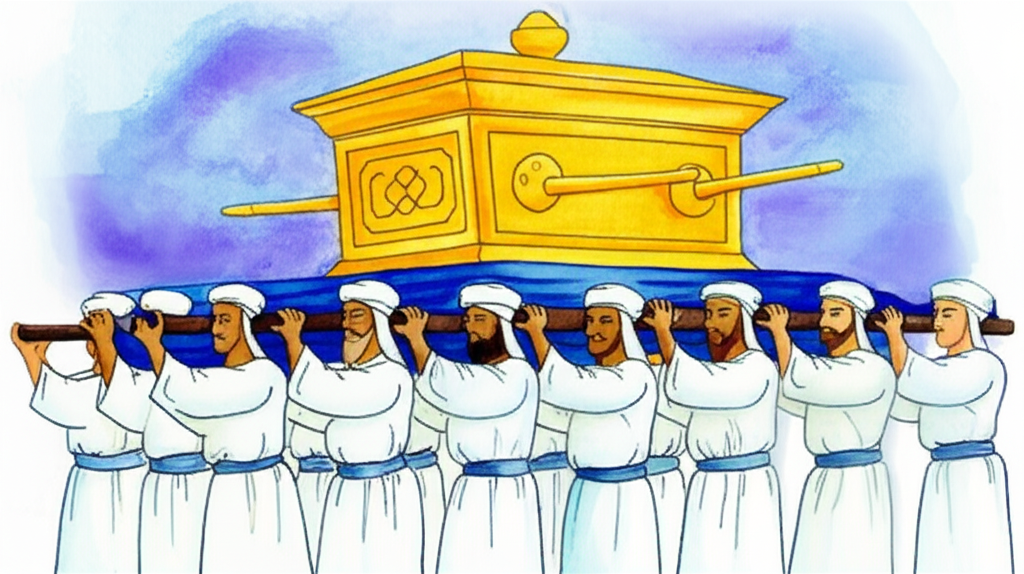
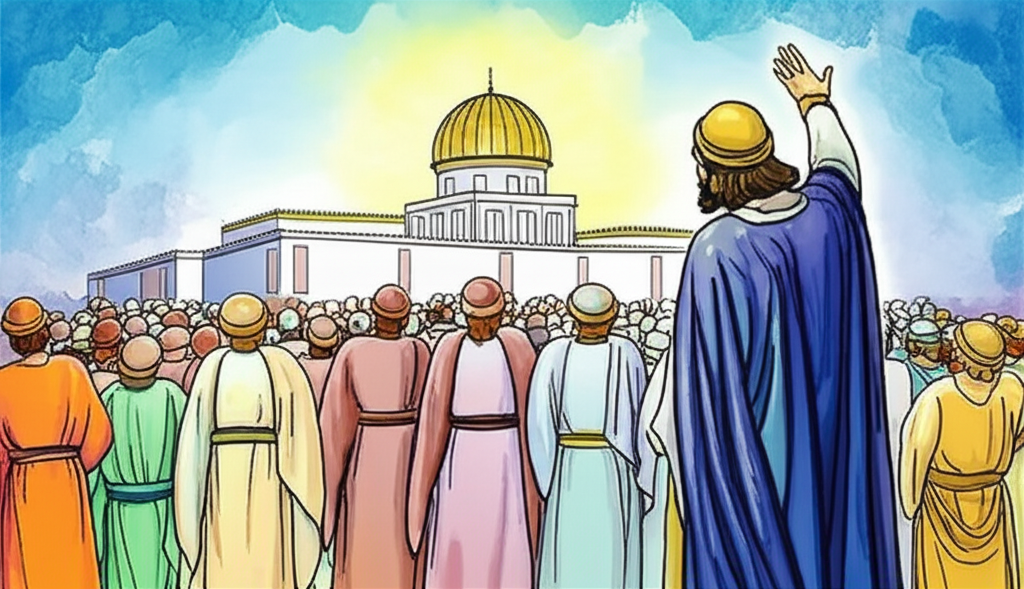
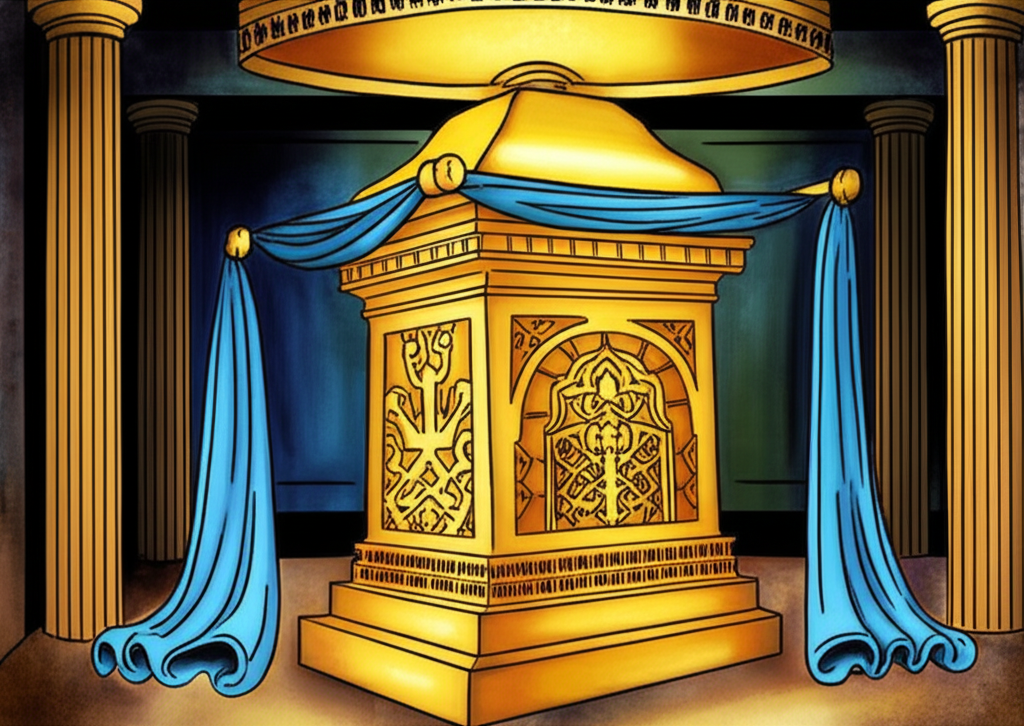
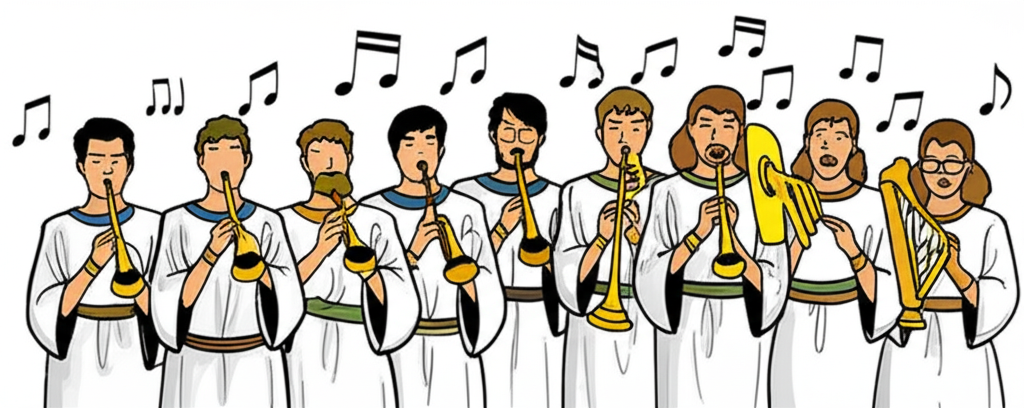
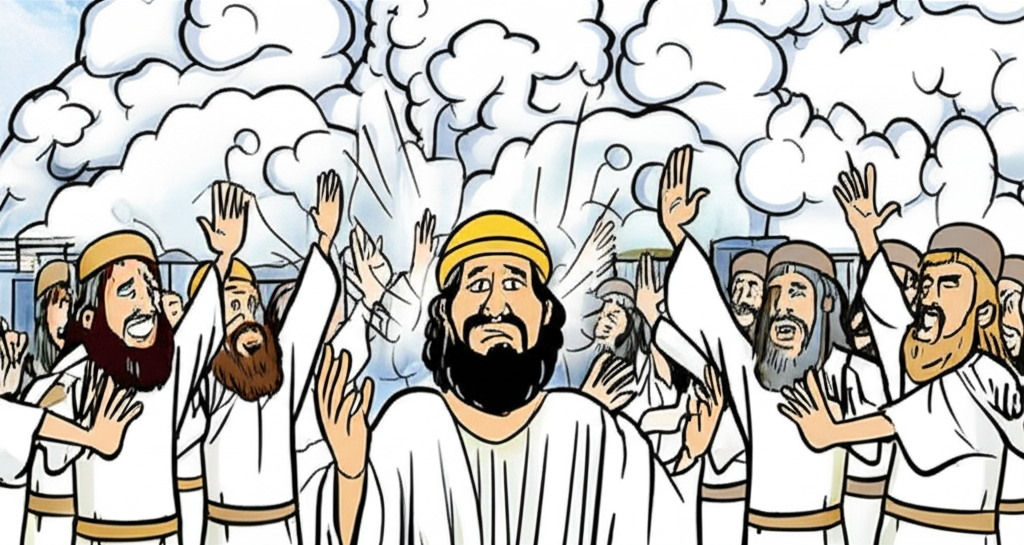

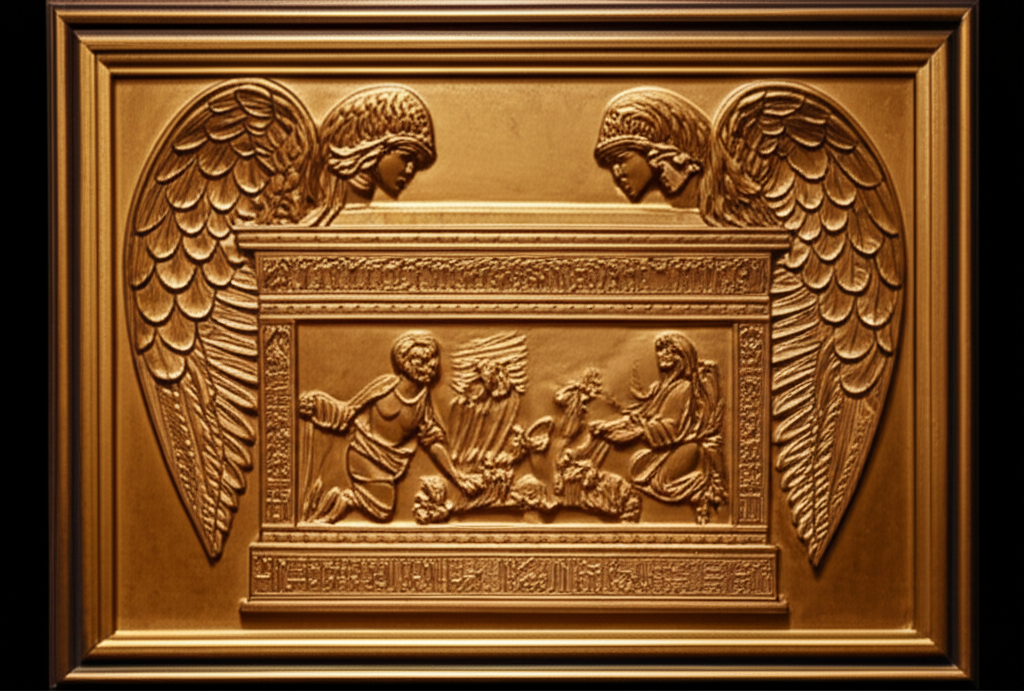
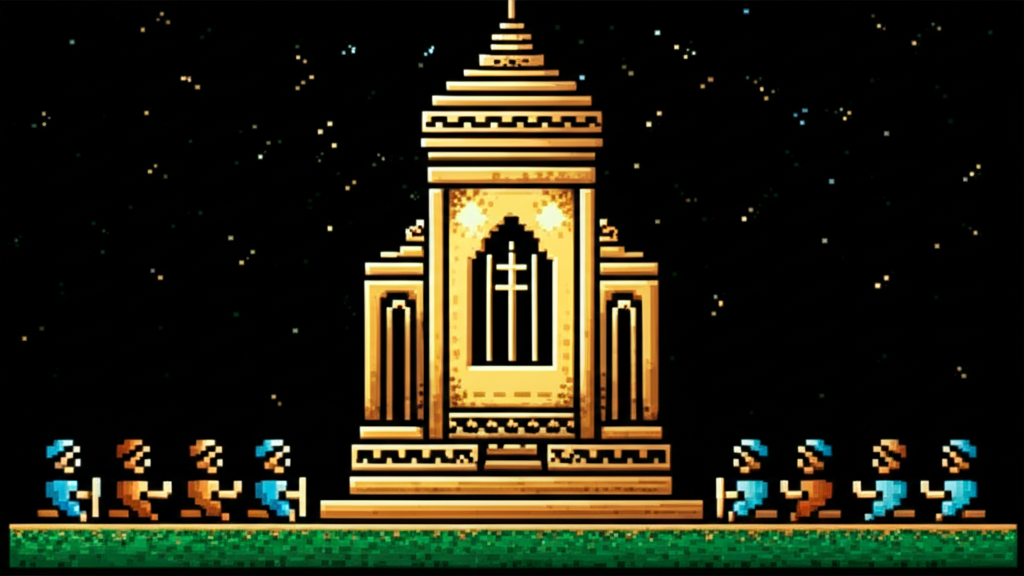
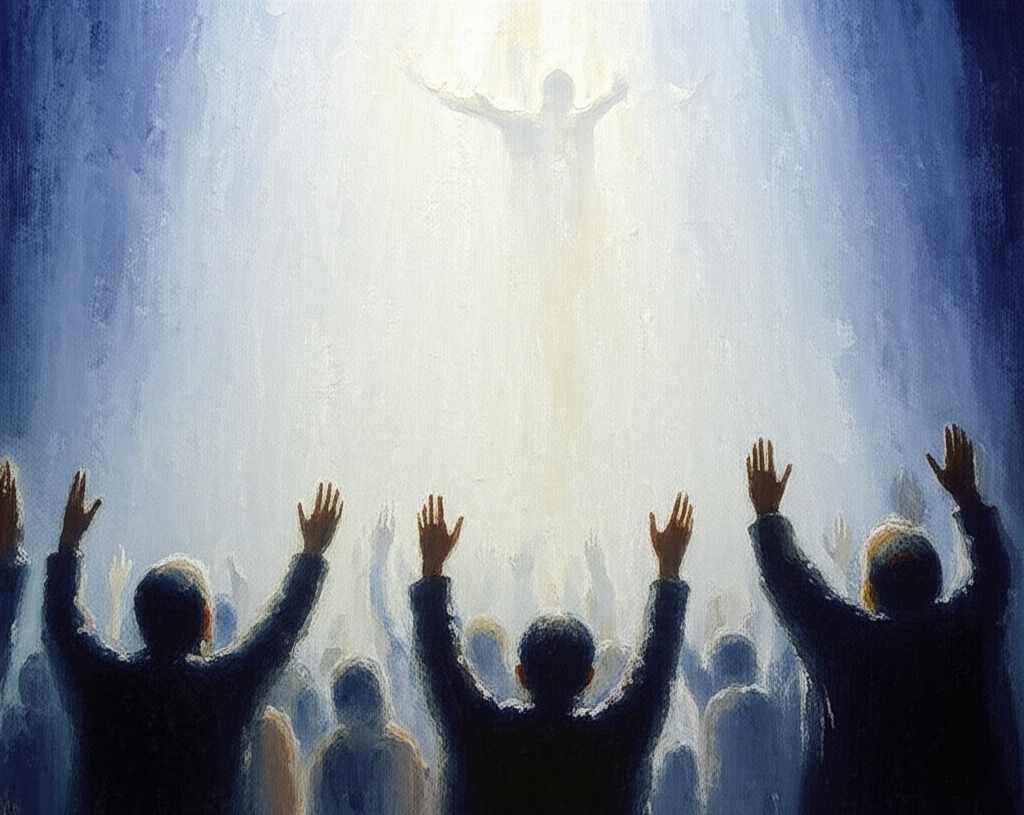
2 Chronicles chapter 5 kjv
- 1 Thus all the work that Solomon made for the house of the LORD was finished: and Solomon brought in all the things that David his father had dedicated; and the silver, and the gold, and all the instruments, put he among the treasures of the house of God.
- 2 Then Solomon assembled the elders of Israel, and all the heads of the tribes, the chief of the fathers of the children of Israel, unto Jerusalem, to bring up the ark of the covenant of the LORD out of the city of David, which is Zion.
- 3 Wherefore all the men of Israel assembled themselves unto the king in the feast which was in the seventh month.
- 4 And all the elders of Israel came; and the Levites took up the ark.
- 5 And they brought up the ark, and the tabernacle of the congregation, and all the holy vessels that were in the tabernacle, these did the priests and the Levites bring up.
- 6 Also king Solomon, and all the congregation of Israel that were assembled unto him before the ark, sacrificed sheep and oxen, which could not be told nor numbered for multitude.
- 7 And the priests brought in the ark of the covenant of the LORD unto his place, to the oracle of the house, into the most holy place, even under the wings of the cherubim:
- 8 For the cherubim spread forth their wings over the place of the ark, and the cherubim covered the ark and the staves thereof above.
- 9 And they drew out the staves of the ark, that the ends of the staves were seen from the ark before the oracle; but they were not seen without. And there it is unto this day.
- 10 There was nothing in the ark save the two tables which Moses put therein at Horeb, when the LORD made a covenant with the children of Israel, when they came out of Egypt.
- 11 And it came to pass, when the priests were come out of the holy place: (for all the priests that were present were sanctified, and did not then wait by course:
- 12 Also the Levites which were the singers, all of them of Asaph, of Heman, of Jeduthun, with their sons and their brethren, being arrayed in white linen, having cymbals and psalteries and harps, stood at the east end of the altar, and with them an hundred and twenty priests sounding with trumpets:)
- 13 It came even to pass, as the trumpeters and singers were as one, to make one sound to be heard in praising and thanking the LORD; and when they lifted up their voice with the trumpets and cymbals and instruments of music, and praised the LORD, saying, For he is good; for his mercy endureth for ever: that then the house was filled with a cloud, even the house of the LORD;
- 14 So that the priests could not stand to minister by reason of the cloud: for the glory of the LORD had filled the house of God.
2 Chronicles chapter 5 nkjv
- 1 So all the work that Solomon had done for the house of the LORD was finished; and Solomon brought in the things which his father David had dedicated: the silver and the gold and all the furnishings. And he put them in the treasuries of the house of God.
- 2 Now Solomon assembled the elders of Israel and all the heads of the tribes, the chief fathers of the children of Israel, in Jerusalem, that they might bring the ark of the covenant of the LORD up from the City of David, which is Zion.
- 3 Therefore all the men of Israel assembled with the king at the feast, which was in the seventh month.
- 4 So all the elders of Israel came, and the Levites took up the ark.
- 5 Then they brought up the ark, the tabernacle of meeting, and all the holy furnishings that were in the tabernacle. The priests and the Levites brought them up.
- 6 Also King Solomon, and all the congregation of Israel who were assembled with him before the ark, were sacrificing sheep and oxen that could not be counted or numbered for multitude.
- 7 Then the priests brought in the ark of the covenant of the LORD to its place, into the inner sanctuary of the temple, to the Most Holy Place, under the wings of the cherubim.
- 8 For the cherubim spread their wings over the place of the ark, and the cherubim overshadowed the ark and its poles.
- 9 The poles extended so that the ends of the poles of the ark could be seen from the holy place, in front of the inner sanctuary; but they could not be seen from outside. And they are there to this day.
- 10 Nothing was in the ark except the two tablets which Moses put there at Horeb, when the LORD made a covenant with the children of Israel, when they had come out of Egypt.
- 11 And it came to pass when the priests came out of the Most Holy Place (for all the priests who were present had sanctified themselves, without keeping to their divisions),
- 12 and the Levites who were the singers, all those of Asaph and Heman and Jeduthun, with their sons and their brethren, stood at the east end of the altar, clothed in white linen, having cymbals, stringed instruments and harps, and with them one hundred and twenty priests sounding with trumpets?
- 13 indeed it came to pass, when the trumpeters and singers were as one, to make one sound to be heard in praising and thanking the LORD, and when they lifted up their voice with the trumpets and cymbals and instruments of music, and praised the LORD, saying: "For He is good, For His mercy endures forever," that the house, the house of the LORD, was filled with a cloud,
- 14 so that the priests could not continue ministering because of the cloud; for the glory of the LORD filled the house of God.
2 Chronicles chapter 5 niv
- 1 When all the work Solomon had done for the temple of the LORD was finished, he brought in the things his father David had dedicated?the silver and gold and all the furnishings?and he placed them in the treasuries of God's temple.
- 2 Then Solomon summoned to Jerusalem the elders of Israel, all the heads of the tribes and the chiefs of the Israelite families, to bring up the ark of the LORD's covenant from Zion, the City of David.
- 3 And all the Israelites came together to the king at the time of the festival in the seventh month.
- 4 When all the elders of Israel had arrived, the Levites took up the ark,
- 5 and they brought up the ark and the tent of meeting and all the sacred furnishings in it. The Levitical priests carried them up;
- 6 and King Solomon and the entire assembly of Israel that had gathered about him were before the ark, sacrificing so many sheep and cattle that they could not be recorded or counted.
- 7 The priests then brought the ark of the LORD's covenant to its place in the inner sanctuary of the temple, the Most Holy Place, and put it beneath the wings of the cherubim.
- 8 The cherubim spread their wings over the place of the ark and covered the ark and its carrying poles.
- 9 These poles were so long that their ends, extending from the ark, could be seen from in front of the inner sanctuary, but not from outside the Holy Place; and they are still there today.
- 10 There was nothing in the ark except the two tablets that Moses had placed in it at Horeb, where the LORD made a covenant with the Israelites after they came out of Egypt.
- 11 The priests then withdrew from the Holy Place. All the priests who were there had consecrated themselves, regardless of their divisions.
- 12 All the Levites who were musicians?Asaph, Heman, Jeduthun and their sons and relatives?stood on the east side of the altar, dressed in fine linen and playing cymbals, harps and lyres. They were accompanied by 120 priests sounding trumpets.
- 13 The trumpeters and musicians joined in unison to give praise and thanks to the LORD. Accompanied by trumpets, cymbals and other instruments, the singers raised their voices in praise to the LORD and sang: "He is good; his love endures forever." Then the temple of the LORD was filled with the cloud,
- 14 and the priests could not perform their service because of the cloud, for the glory of the LORD filled the temple of God.
2 Chronicles chapter 5 esv
- 1 Thus all the work that Solomon did for the house of the LORD was finished. And Solomon brought in the things that David his father had dedicated, and stored the silver, the gold, and all the vessels in the treasuries of the house of God.
- 2 Then Solomon assembled the elders of Israel and all the heads of the tribes, the leaders of the fathers' houses of the people of Israel, in Jerusalem, to bring up the ark of the covenant of the LORD out of the city of David, which is Zion.
- 3 And all the men of Israel assembled before the king at the feast that is in the seventh month.
- 4 And all the elders of Israel came, and the Levites took up the ark.
- 5 And they brought up the ark, the tent of meeting, and all the holy vessels that were in the tent; the Levitical priests brought them up.
- 6 And King Solomon and all the congregation of Israel, who had assembled before him, were before the ark, sacrificing so many sheep and oxen that they could not be counted or numbered.
- 7 Then the priests brought the ark of the covenant of the LORD to its place, in the inner sanctuary of the house, in the Most Holy Place, underneath the wings of the cherubim.
- 8 The cherubim spread out their wings over the place of the ark, so that the cherubim made a covering above the ark and its poles.
- 9 And the poles were so long that the ends of the poles were seen from the Holy Place before the inner sanctuary, but they could not be seen from outside. And they are there to this day.
- 10 There was nothing in the ark except the two tablets that Moses put there at Horeb, where the LORD made a covenant with the people of Israel, when they came out of Egypt.
- 11 And when the priests came out of the Holy Place (for all the priests who were present had consecrated themselves, without regard to their divisions,
- 12 and all the Levitical singers, Asaph, Heman, and Jeduthun, their sons and kinsmen, arrayed in fine linen, with cymbals, harps, and lyres, stood east of the altar with 120 priests who were trumpeters;
- 13 and it was the duty of the trumpeters and singers to make themselves heard in unison in praise and thanksgiving to the LORD), and when the song was raised, with trumpets and cymbals and other musical instruments, in praise to the LORD, "For he is good, for his steadfast love endures forever," the house, the house of the LORD, was filled with a cloud,
- 14 so that the priests could not stand to minister because of the cloud, for the glory of the LORD filled the house of God.
2 Chronicles chapter 5 nlt
- 1 So Solomon finished all his work on the Temple of the LORD. Then he brought all the gifts his father, David, had dedicated ? the silver, the gold, and the various articles ? and he stored them in the treasuries of the Temple of God.
- 2 Solomon then summoned to Jerusalem the elders of Israel and all the heads of tribes ? the leaders of the ancestral families of Israel. They were to bring the Ark of the LORD's Covenant to the Temple from its location in the City of David, also known as Zion.
- 3 So all the men of Israel assembled before the king at the annual Festival of Shelters, which is held in early autumn.
- 4 When all the elders of Israel arrived, the Levites picked up the Ark.
- 5 The priests and Levites brought up the Ark along with the special tent and all the sacred items that had been in it.
- 6 There, before the Ark, King Solomon and the entire community of Israel sacrificed so many sheep, goats, and cattle that no one could keep count!
- 7 Then the priests carried the Ark of the LORD's Covenant into the inner sanctuary of the Temple ? the Most Holy Place ? and placed it beneath the wings of the cherubim.
- 8 The cherubim spread their wings over the Ark, forming a canopy over the Ark and its carrying poles.
- 9 These poles were so long that their ends could be seen from the Holy Place, which is in front of the Most Holy Place, but not from the outside. They are still there to this day.
- 10 Nothing was in the Ark except the two stone tablets that Moses had placed in it at Mount Sinai, where the LORD made a covenant with the people of Israel when they left Egypt.
- 11 Then the priests left the Holy Place. All the priests who were present had purified themselves, whether or not they were on duty that day.
- 12 And the Levites who were musicians ? Asaph, Heman, Jeduthun, and all their sons and brothers ? were dressed in fine linen robes and stood at the east side of the altar playing cymbals, lyres, and harps. They were joined by 120 priests who were playing trumpets.
- 13 The trumpeters and singers performed together in unison to praise and give thanks to the LORD. Accompanied by trumpets, cymbals, and other instruments, they raised their voices and praised the LORD with these words: "He is good!
His faithful love endures forever!"
At that moment a thick cloud filled the Temple of the LORD. - 14 The priests could not continue their service because of the cloud, for the glorious presence of the LORD filled the Temple of God.
- Bible Book of 2 Chronicles
- 1 Solomon Worships at Gibeon
- 2 Preparing to Build the Temple
- 3 Solomon Builds the Temple
- 4 The Temple's Furnishings
- 5 The Ark Brought to the Temple
- 6 Solomon Blesses the People
- 7 Shekinah glory of God
- 8 Solomon's Accomplishments
- 9 The Queen of Sheba
- 10 The Revolt Against Rehoboam
- 11 Rehoboam Secures His Kingdom
- 12 Egypt Plunders Jerusalem
- 13 Abijah Reigns in Judah
- 14 King Asa of Judah
- 15 Asa's Religious Reforms
- 16 Asa's Last Years
- 17 Jehoshaphat Reigns in Judah
- 18 Jehoshaphat Allies with Ahab
- 19 Jehoshaphat's Reforms
- 20 King Jehoshaphat's Prayer
- 21 Jehoram Reigns in Judah
- 22 Ahaziah Reigns in Judah
- 23 Joash Made King
- 24 King Joash Repairs the Temple
- 25 Amaziah Reigns in Judah
- 26 King Uzziah Reigns in Judah
- 27 Jotham Reigns in Judah
- 28 Ahaz Reigns in Judah
- 29 Hezekiah Reigns in Judah
- 30 Passover Celebrated
- 31 Hezekiah Organizes the Priests
- 32 Sennacherib Boasts Against the Lord
- 33 Manasseh Reigns in Judah
- 34 Josiah Reigns in Judah
- 35 Josiah Keeps the Passover
- 36 Judah's Decline